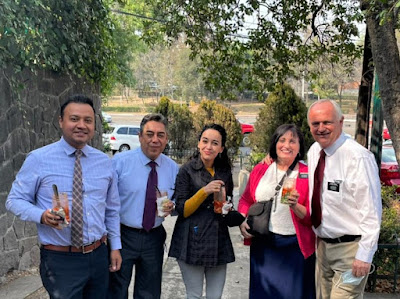Happy Easter!
 |
| Ron and Zoila Camejo, who did all the cooking |
 |
| We managed to get all of us at tables in the Davises' apartment. |
 |
| I took this photo from the rooftop restaurant where we ate. If you really zoomed in, you might be able to see the pyramid, which is sitting on the right edge of the dip between the peaks. |
 |
| Vicki zoomed in with her phone to take this photo. You can see the pyramid sitting just left of center. |
 |
| I enjoyed shopping at the booths.... |
 |
| ....Ron preferred shopping here. |
We spent the night at a hotel in Cuernavaca. I booked the hotel after looking at reviews online, which is always a little dicey, but it turned out to be a really nice hotel with comfortable beds and a nice pool area. Cuernavaca is known as “the land of eternal spring.” We’ve been told that people in Mexico City go there for the weekends to enjoy the “nice weather.” We found that hard to believe since to us, the weather in Mexico City is about as perfect as it can be. And indeed, we didn’t find the weather in Cuernavaca better—in fact to our minds, it was worse. It was hot! Tom Deaver kept checking the temperature on his phone, and at one point it hit 95 degrees Fahrenheit and was still climbing.
 |
| "The Gardens of Mexico" prided itself on being eco-friendly. These shade structures in the parking lot were actually solar panels. |
 |
| This lovely lake was just inside the entrance. |
 |
| I thought this was a cute picture of Ron and Tom walking along a bamboo lined path. |
 |
| The tropical garden included a greenhouse full of blooming orhids. |
 |
| The Italian garden |
 |
| The Japanese garden |
 |
| Vicki Deaver in the Japanese garden. |
 |
| The paths in the labyrinth when under AND over tunnels like this one. |
 |
| Tom Deaver said I should have kicked my feet up in the air for this photo. |
We got home from Cuernavaca in time to go up to the pueblito
with the Frandsens and the Camejos. The community was celebrating Good Friday
and the Catholic church was open. We are seldom able to see inside it, but that
evening they had the doors thrown wide open while the Mass was going on. We didn’t
want to intrude on their worship, so we didn’t go inside. Instead, we stood outside
and watched. A group of people who were also waiting outside were wearing long
black tunics. Tracy Frandsen was the first of our group to go over to talk to
them. The Camejos were next, and then the rest of us. The people told us about
their traditions, which included a procession which was going to begin as soon
as the Mass was over. We would have liked to have seen it, but it was getting
late and we were exhausted from traveling, so we left. We stopped at a booth
selling bread and Ron bought a large, almost loaf sized, sweet roll. A boy who
looked to be about 10 was at the booth. Ron asked him what the roll cost. The
boy said 100 pesos. that is about $5 US and seemed high, but the boy didn’t
budge, so Ron paid him 100 pesos. When the Camejos heard how much Ron paid,
they taught him a new Spanish verb, “estafar,” which means “to swindle” as in “You
just got swindled by a child.”
 |
| The entrance to the church grounds in the pueblito. |
 |
| Us, Tracy Frandsen, the Camejos, and our new friends who taught us about their traditions. We always love learning how other people and faiths worship and honor Jesus Christ. |
 |
| The little salesman who sold Ron a roll that we dubbed "Pan de Oro" (bread of gold.) |
Saturday we and the Deavers went to the Frida Kahlo museum in Coyoacan, which is one of my favorite communities in Mexico City. I’m not a huge fan of Frida Kahlo, but Mexico loves her, and the museum is considered one of the top sites to see in the city, so I figured we should go see it. It is called La Casa Azul (the blue house) because the outside walls are painted a bright cobalt blue. It is the house where Frida Kahlo was born, where she grew up, where she lived with her husband, Diego Rivera, and where she died. It was interesting to see this place that was so integral to her life. I especially liked the kitchen and the studio where she painted. She had a large easel which was given to her by Norman Rockwell. If I were to try to think of two artists whose style and messages seemed opposite, I couldn’t come up with two more different than Frida Kahlo and Norman Rockwell, but I guess talent admires talent. It was also interesting to learn more about her life, which was quite tragic. The house and garden were lovely, but had a melancholy feeling about them. We weren’t allowed to take photos inside, but we could take them in the garden, which the house was built around.
After we finished at the museum, we walked to the historic plaza
of Coyoacan. The Frandsens met us there for dinner at a restaurant they recommended
and which sits just off the plaza. As I said, Coyoacan is one of my favorite
places in Mexico City, but that day it seemed like everyone who hadn’t left the
city for the holiday was in Coyoacan. The Deavers hadn’t been there before, and
I’d told them how much I liked it. I think they wondered what I saw in it,
because being there with such a large throng of people that it was hard to see
anything. I told them they’d have to go back on a normal Saturday when there is
just enough of a crowd to feel festive. But despite the crowd, we did manage to
have a fun time.
 |
| The Deavers at the fountain at Coyoacan. It took some patience and a bit of editing to get a photo without a whole crowd of people in it. |
 |
| This statue is a real live person! |
 |
| Guacamole, always a favorite! |
I’m going to close with this poem which has been precious to
me for decades. It seems perfect for honoring Easter because its message speaks
directly to the meaning and purpose of Christ’s atoning sacrifice. It is one
thing to say, “Jesus atoned for the world,” but it is another thing completely
to be say, “Jesus atoned for me.” This poem expresses that beautifully
in a way that speaks to my heart. It was originally published in the April 1985
New Era. The author is Margery Stockseth, and it is entitled, “He
Thought of Me.”
I am worth the coming down,
the silence
in return for mockery.
I am worth the thorns,
the bleeding back,
the wincing, weakening steps to
Calvary.
He suffered these and thought of
me.
He could have halted soldiers
with a fiery eye,
And pronounced death
in words that rang
from marble palace walls,
And in the garden dreamed instead
of prayed.
But as the glistening crimson
beads
slipped from his face,
He thought that I was worth the
price he paid.
I’m blind to what
he sees in me,
Yet I know thorns
and what it is
to wince and weaken.
Gethsemane and Calvary—
He suffered so
and thought of me.

















Comments
Post a Comment